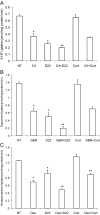Selective transport of monoamine neurotransmitters by human plasma membrane monoamine transporter and organic cation transporter 3
- PMID: 20858707
- PMCID: PMC2993547
- DOI: 10.1124/jpet.110.170142
Selective transport of monoamine neurotransmitters by human plasma membrane monoamine transporter and organic cation transporter 3
Abstract
The plasma membrane monoamine transporter (PMAT) and organic cation transporter 3 (OCT3) are the two most prominent low-affinity, high-capacity (i.e., uptake(2)) transporters for endogenous biogenic amines. Using the Flp-in system, we expressed human PMAT (hPMAT) and human OCT3 (hOCT3) at similar levels in human embryonic kidney 293 cells. Parallel and detailed kinetics analysis revealed distinct and seemingly complementary patterns for the two transporters in transporting monoamine neurotransmitters. hPMAT is highly selective toward serotonin (5-HT) and dopamine, with the rank order of transport efficiency (V(max)/K(m)) being: dopamine, 5-HT ≫ histamine, norepinephrine, epinephrine. The substrate preference of hPMAT toward these amines is substantially driven by large (up to 15-fold) distinctions in its apparent binding affinities (K(m)). In contrast, hOCT3 is less selective than hPMAT toward the monoamines, and the V(max)/K(m) rank order for hOCT3 is: histamine > norepinephrine, epinephrine > dopamine >5-HT. It is noteworthy that hOCT3 demonstrated comparable (≤2-fold difference) K(m) toward all amines, and distinctions in V(max) played an important role in determining its differential transport efficiency toward the monoamines. Real-time reverse transcription-polymerase chain reaction revealed that hPMAT is expressed at much higher levels than hOCT3 in most human brain areas, whereas hOCT3 is selectively and highly expressed in adrenal gland and skeletal muscle. Our results suggest that hOCT3 represents a major uptake(2) transporter for histamine, epinephrine, and norepinephrine. hPMAT, on the other hand, is a major uptake(2) transporter for 5-HT and dopamine and may play a more important role in transporting these two neurotransmitters in the central nervous system.
Figures







References
-
- Amara SG, Kuhar MJ. (1993) Neurotransmitter transporters: recent progress. Annu Rev Neurosci 16:73–93 - PubMed
-
- Amphoux A, Vialou V, Drescher E, Brüss M, Mannoury La Cour C, Rochat C, Millan MJ, Giros B, Bönisch H, Gautron S. (2006) Differential pharmacological in vitro properties of organic cation transporters and regional distribution in rat brain. Neuropharmacology 50:941–952 - PubMed
-
- Andersen PH. (1989) The dopamine inhibitor GBR 12909: selectivity and molecular mechanism of action. Eur J Pharmacol 166:493–504 - PubMed
-
- Blakely RD, De Felice LJ, Hartzell HC. (1994) Molecular physiology of norepinephrine and serotonin transporters. J Exp Biol 196:263–281 - PubMed
-
- Bönisch H, Bryan LJ, Henseling M, O'Donnell SR, Stockmann P, Trendelenburg U. (1985) The effect of various ions on uptake2 of catecholamines. Naunyn Schmiedebergs Arch Pharmacol 328:407–416 - PubMed
Publication types
MeSH terms
Substances
Grants and funding
LinkOut - more resources
Full Text Sources
Molecular Biology Databases

